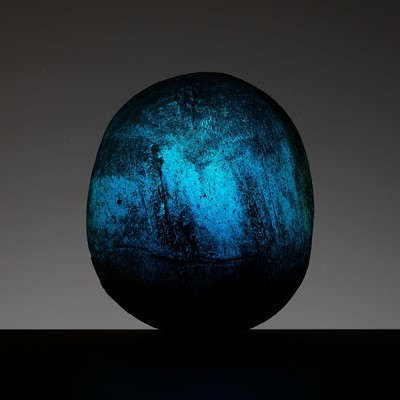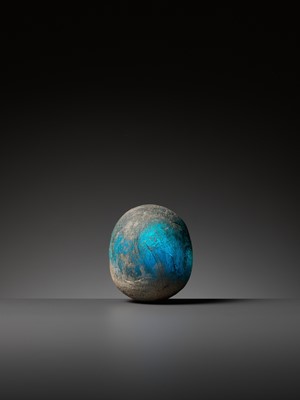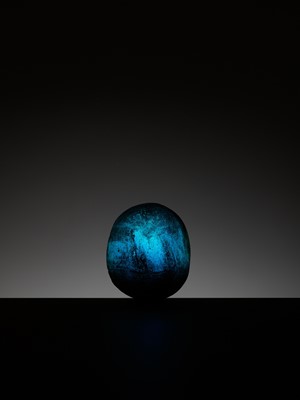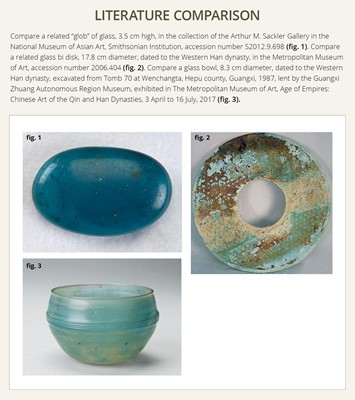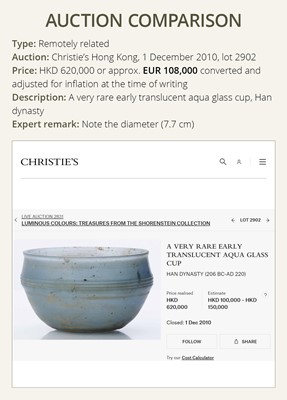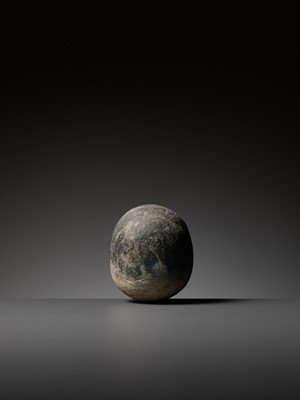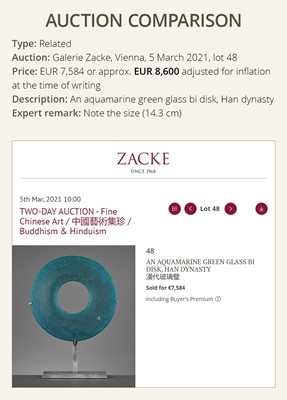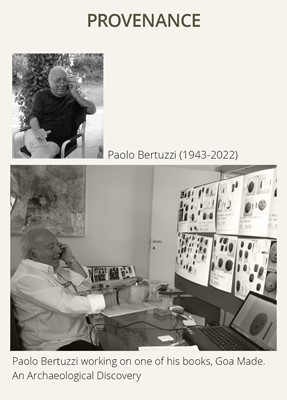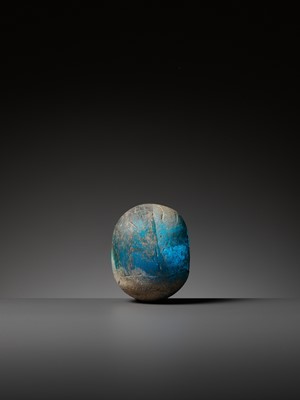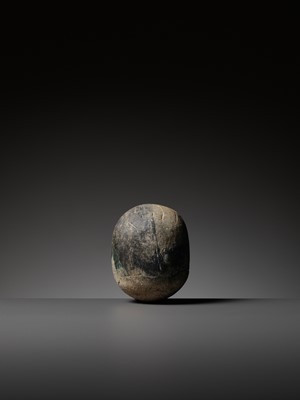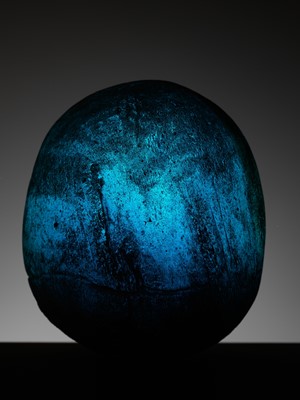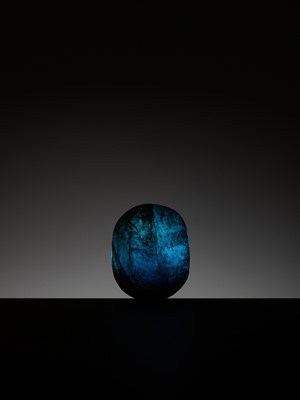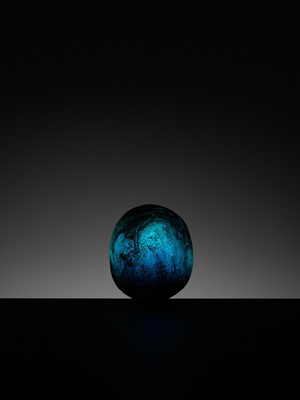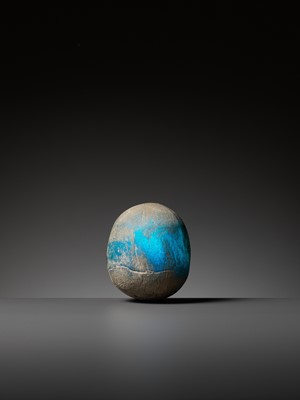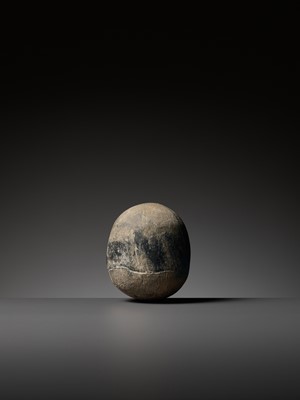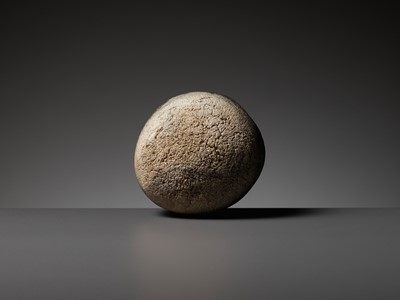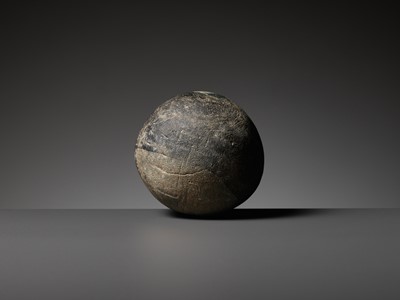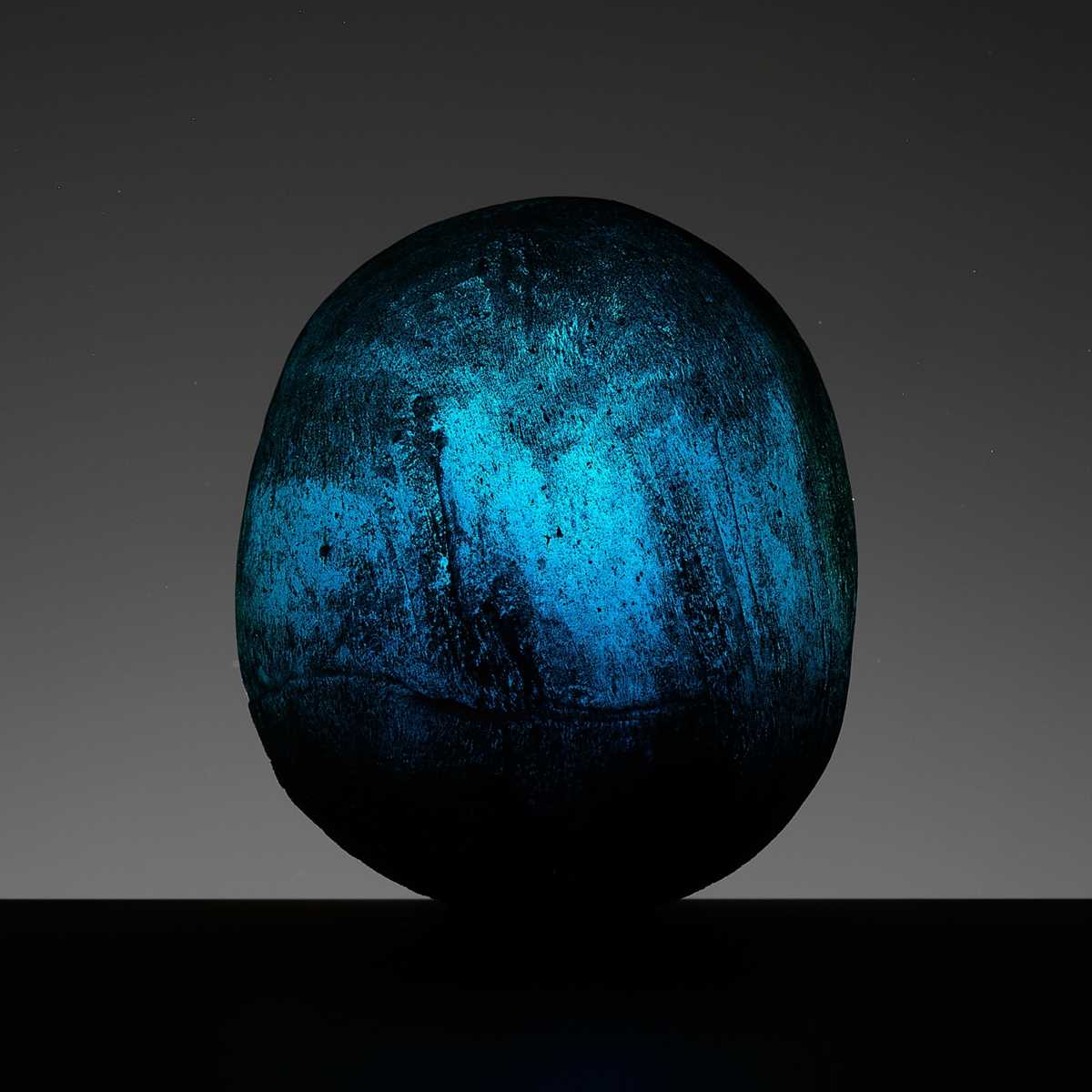9th Mar, 2023 13:00
TWO-DAY AUCTION - Fine Chinese Art / 中國藝術集珍 / Buddhism & Hinduism
146
A TRANSLUCENT AQUAMARINE GLASS ‘COSMIC EGG’, HAN DYNASTY
漢代海藍寶石色玻璃蛋
Sold for €2,860
including Buyer's Premium
China, 202 BC to 220 AD. The ritual object of ovoid form, the deep-blue glass of high translucency.
Provenance: Paolo Bertuzzi (1943-2022), who was a fashion stylist from Bologna, Italy. He was the son of Enrichetta Bertuzzi, founder of Hettabretz, a noted Italian fashion company with customers such as the Rothschild family, Audrey Hepburn, and Elizabeth Taylor. Paolo Bertuzzi later took over his mother’s business and designed exclusive pieces, some of which were exhibited in the Costume Institute of the Metropolitan Museum in New York, USA. He was also an avid collector of antiques for more than 60 years. His collection includes both archaic and contemporary art, and he edited two important books about Asian art, Goa Made - An Archaeological Discovery, about a large-scale archaeological project carried out with the Italian and Indonesian governments, and Majapahit, Masterpieces from a Forgotten Kingdom.
Condition: Good condition, commensurate with age. Extensive wear, small losses, nicks, scratches, cracks, extensive signs of weathering and erosion. Displaying remarkably well overall.
Weight: 852.2 g
Dimensions: Height 9.5 cm
In Chinese history, glass played a peripheral role in arts and crafts when compared to ceramics and metal work. The limited archaeological distribution and use of glass objects are evidence of the rarity of the material. Literary sources date the first manufacture of glass to the 5th century AD. However, the earliest archaeological evidence for glass manufacture in China comes from the Warring States period. The Chinese learned to manufacture glass comparatively later than the Mesopotamians, Egyptians and Indians. Imported glass objects first reached China during the late Spring and Autumn and early Warring States periods, c. early 5th century BC, in the form of polychrome ‘eye beads’. These imports created the impetus for the production of indigenous glass beads. During the Han dynasty, the use of glass diversified. The introduction of glass casting in this period encouraged the production of molded objects, such as bi disks and other ritual objects.
The cosmic egg is a mythological motif found in the cosmogonies of the Proto-Indo-European culture and several other major civilizations. Typically, the world egg is a beginning of some sort, and the universe or some primordial being comes into existence by "hatching" from the egg, sometimes lain on the primordial waters of the Earth. Eggs symbolize the unification of two complementary principles (represented by the egg white and the yolk) from which life or existence, in its most fundamental philosophical sense, emerges.
In the myth of Pangu, developed by Taoist monks hundreds of years after Lao Zi, the universe began as an egg that symbolizes the primordial state of Taiji. A primeval hermaphroditic giant named Pangu, born inside the egg, broke it into two halves: the upper half became the sky, while the lower half became the earth. As the god grew taller, the sky and the earth grew thicker and were separated further. Finally Pangu died and his body parts became the sun, moon, different parts of the earth and living things. The first writer to record the myth of Pangu was Xu Zheng during the Three Kingdoms period. Recently his name was found in a tomb dated AD 156, during the later Han period.
Literature comparison:
Compare a related “glob” of glass, 3.5 cm high, in the collection of the Arthur M. Sackler Gallery in the National Museum of Asian Art, Smithsonian Institution, accession number S2012.9.698. Compare a related glass bi disk, 17.8 cm diameter, dated to the Western Han dynasty, in the Metropolitan Museum of Art, accession number 2006.404. Compare a glass bowl, 8.3 cm diameter, dated to the Western Han dynasty, excavated from Tomb 70 at Wenchangta, Hepu county, Guangxi, 1987, lent by the Guangxi Zhuang Autonomous Region Museum, exhibited in The Metropolitan Museum of Art, Age of Empires: Chinese Art of the Qin and Han Dynasties, 3 April to 16 July, 2017.
Auction result comparison:
Type: Related
Auction: Galerie Zacke, Vienna, 5 March 2021, lot 48
Price: EUR 7,584 or approx. EUR 8,600 adjusted for inflation at the time of writing
Description: An aquamarine green glass bi disk, Han dynasty
Expert remark: Note the size (14.3 cm)
Auction result comparison:
Type: Remotely related
Auction: Christie’s Hong Kong, 1 December 2010, lot 2902
Price: HKD 620,000 or approx. EUR 108,000 converted and adjusted for inflation at the time of writing
Description: A very rare early translucent aqua glass cup, Han dynasty
Expert remark: Note the diameter (7.7 cm)
漢代海藍寶石色玻璃蛋
中國,公元前202 年至公元 220 年。半透明海藍寶石色玻璃,橢圓形禮器。
來源:Paolo Bertuzzi (1943-2022年) 收藏。Paolo Bertuzzi是來自義大利博洛尼亞的時尚造型師。他是 Hettabretz 的創始人 Enrichetta Bertuzzi 的兒子,Hettabretz 是一家著名的義大利時裝公司,客戶包括羅斯柴爾德家族、奧黛麗赫本和伊麗莎白泰勒。Paolo Bertuzzi 後來接手了他母親的生意並設計了獨家作品,其中一些作品在美國紐約大都會博物館服裝學院展出。六十多年來,他還是一位狂熱的古董收藏家。他的收藏包括古代和當代藝術,他編輯了兩本關於亞洲藝術的重要書籍,《Goa Made - An Archaeological Discovery》-關於義大利和印度尼西亞政府合作的大規模考古項目,以及《滿者伯夷-來自被遺忘王國的傑作》。
品相:狀況良好,磨損、輕微的缺損、刻痕、劃痕、裂縫、風化和侵蝕跡象。
重量:852.2 克
尺寸:高9.5 厘米
在中國歷史上,與陶瓷和金屬製品相比,玻璃在手工藝品中扮演著外圍角色。有限的考古出土説明了玻璃製品的使用并不廣汎。中國最早的玻璃製造大約在戰國時期。中國人學會製造玻璃的時間比美索不達米亞人、埃及人和印度人要晚。進口玻璃器物在春秋末戰國初期首次到達中國,這些進口產品推動了本地玻璃的生產。漢代,玻璃的用途非常多樣化。
文獻比較:
比較一件相近玻璃球,長3.5 厘米,收藏於Arthur M. Sackler Gallery ,National Museum of Asian Art,Smithsonian Institution,館藏編號S2012.9.698。比較一件相近西漢的玻璃璧,直徑17.8 厘米,收藏於大都會博物館,館藏編號2006.404。比較一件西漢的玻璃碗,直徑8.3 厘米,1987年出土於廣西合浦文昌塔70號墓地,收藏於Guangxi Zhuang Autonomous Region Museum,展覽於大都會藝術博物館,《Age of Empires: Chinese Art of the Qin and Han Dynasties》,2017年4月3日至7月 16日。
拍賣結果比較:
形制:相近
拍賣:維也納Galerie Zacke,2021年3月5日,lot 48
價格:EUR 7,584(相當於今日EUR 8,600)
描述:漢代玻璃璧
專家評論:請注意尺寸(14.3 厘米) 。
拍賣結果比較:
形制:稍微相近
拍賣:香港佳士得,2010年12月1日,lot 2902
價格:HKD 620,000(相當於今日EUR 108,000)
描述:漢湖水綠玻璃弦紋盃
專家評論:請注意直徑(7.7 厘米)。
China, 202 BC to 220 AD. The ritual object of ovoid form, the deep-blue glass of high translucency.
Provenance: Paolo Bertuzzi (1943-2022), who was a fashion stylist from Bologna, Italy. He was the son of Enrichetta Bertuzzi, founder of Hettabretz, a noted Italian fashion company with customers such as the Rothschild family, Audrey Hepburn, and Elizabeth Taylor. Paolo Bertuzzi later took over his mother’s business and designed exclusive pieces, some of which were exhibited in the Costume Institute of the Metropolitan Museum in New York, USA. He was also an avid collector of antiques for more than 60 years. His collection includes both archaic and contemporary art, and he edited two important books about Asian art, Goa Made - An Archaeological Discovery, about a large-scale archaeological project carried out with the Italian and Indonesian governments, and Majapahit, Masterpieces from a Forgotten Kingdom.
Condition: Good condition, commensurate with age. Extensive wear, small losses, nicks, scratches, cracks, extensive signs of weathering and erosion. Displaying remarkably well overall.
Weight: 852.2 g
Dimensions: Height 9.5 cm
In Chinese history, glass played a peripheral role in arts and crafts when compared to ceramics and metal work. The limited archaeological distribution and use of glass objects are evidence of the rarity of the material. Literary sources date the first manufacture of glass to the 5th century AD. However, the earliest archaeological evidence for glass manufacture in China comes from the Warring States period. The Chinese learned to manufacture glass comparatively later than the Mesopotamians, Egyptians and Indians. Imported glass objects first reached China during the late Spring and Autumn and early Warring States periods, c. early 5th century BC, in the form of polychrome ‘eye beads’. These imports created the impetus for the production of indigenous glass beads. During the Han dynasty, the use of glass diversified. The introduction of glass casting in this period encouraged the production of molded objects, such as bi disks and other ritual objects.
The cosmic egg is a mythological motif found in the cosmogonies of the Proto-Indo-European culture and several other major civilizations. Typically, the world egg is a beginning of some sort, and the universe or some primordial being comes into existence by "hatching" from the egg, sometimes lain on the primordial waters of the Earth. Eggs symbolize the unification of two complementary principles (represented by the egg white and the yolk) from which life or existence, in its most fundamental philosophical sense, emerges.
In the myth of Pangu, developed by Taoist monks hundreds of years after Lao Zi, the universe began as an egg that symbolizes the primordial state of Taiji. A primeval hermaphroditic giant named Pangu, born inside the egg, broke it into two halves: the upper half became the sky, while the lower half became the earth. As the god grew taller, the sky and the earth grew thicker and were separated further. Finally Pangu died and his body parts became the sun, moon, different parts of the earth and living things. The first writer to record the myth of Pangu was Xu Zheng during the Three Kingdoms period. Recently his name was found in a tomb dated AD 156, during the later Han period.
Literature comparison:
Compare a related “glob” of glass, 3.5 cm high, in the collection of the Arthur M. Sackler Gallery in the National Museum of Asian Art, Smithsonian Institution, accession number S2012.9.698. Compare a related glass bi disk, 17.8 cm diameter, dated to the Western Han dynasty, in the Metropolitan Museum of Art, accession number 2006.404. Compare a glass bowl, 8.3 cm diameter, dated to the Western Han dynasty, excavated from Tomb 70 at Wenchangta, Hepu county, Guangxi, 1987, lent by the Guangxi Zhuang Autonomous Region Museum, exhibited in The Metropolitan Museum of Art, Age of Empires: Chinese Art of the Qin and Han Dynasties, 3 April to 16 July, 2017.
Auction result comparison:
Type: Related
Auction: Galerie Zacke, Vienna, 5 March 2021, lot 48
Price: EUR 7,584 or approx. EUR 8,600 adjusted for inflation at the time of writing
Description: An aquamarine green glass bi disk, Han dynasty
Expert remark: Note the size (14.3 cm)
Auction result comparison:
Type: Remotely related
Auction: Christie’s Hong Kong, 1 December 2010, lot 2902
Price: HKD 620,000 or approx. EUR 108,000 converted and adjusted for inflation at the time of writing
Description: A very rare early translucent aqua glass cup, Han dynasty
Expert remark: Note the diameter (7.7 cm)
漢代海藍寶石色玻璃蛋
中國,公元前202 年至公元 220 年。半透明海藍寶石色玻璃,橢圓形禮器。
來源:Paolo Bertuzzi (1943-2022年) 收藏。Paolo Bertuzzi是來自義大利博洛尼亞的時尚造型師。他是 Hettabretz 的創始人 Enrichetta Bertuzzi 的兒子,Hettabretz 是一家著名的義大利時裝公司,客戶包括羅斯柴爾德家族、奧黛麗赫本和伊麗莎白泰勒。Paolo Bertuzzi 後來接手了他母親的生意並設計了獨家作品,其中一些作品在美國紐約大都會博物館服裝學院展出。六十多年來,他還是一位狂熱的古董收藏家。他的收藏包括古代和當代藝術,他編輯了兩本關於亞洲藝術的重要書籍,《Goa Made - An Archaeological Discovery》-關於義大利和印度尼西亞政府合作的大規模考古項目,以及《滿者伯夷-來自被遺忘王國的傑作》。
品相:狀況良好,磨損、輕微的缺損、刻痕、劃痕、裂縫、風化和侵蝕跡象。
重量:852.2 克
尺寸:高9.5 厘米
在中國歷史上,與陶瓷和金屬製品相比,玻璃在手工藝品中扮演著外圍角色。有限的考古出土説明了玻璃製品的使用并不廣汎。中國最早的玻璃製造大約在戰國時期。中國人學會製造玻璃的時間比美索不達米亞人、埃及人和印度人要晚。進口玻璃器物在春秋末戰國初期首次到達中國,這些進口產品推動了本地玻璃的生產。漢代,玻璃的用途非常多樣化。
文獻比較:
比較一件相近玻璃球,長3.5 厘米,收藏於Arthur M. Sackler Gallery ,National Museum of Asian Art,Smithsonian Institution,館藏編號S2012.9.698。比較一件相近西漢的玻璃璧,直徑17.8 厘米,收藏於大都會博物館,館藏編號2006.404。比較一件西漢的玻璃碗,直徑8.3 厘米,1987年出土於廣西合浦文昌塔70號墓地,收藏於Guangxi Zhuang Autonomous Region Museum,展覽於大都會藝術博物館,《Age of Empires: Chinese Art of the Qin and Han Dynasties》,2017年4月3日至7月 16日。
拍賣結果比較:
形制:相近
拍賣:維也納Galerie Zacke,2021年3月5日,lot 48
價格:EUR 7,584(相當於今日EUR 8,600)
描述:漢代玻璃璧
專家評論:請注意尺寸(14.3 厘米) 。
拍賣結果比較:
形制:稍微相近
拍賣:香港佳士得,2010年12月1日,lot 2902
價格:HKD 620,000(相當於今日EUR 108,000)
描述:漢湖水綠玻璃弦紋盃
專家評論:請注意直徑(7.7 厘米)。
Zacke Live Online Bidding
Our online bidding platform makes it easier than ever to bid in our auctions! When you bid through our website, you can take advantage of our premium buyer's terms without incurring any additional online bidding surcharges.
To bid live online, you'll need to create an online account. Once your account is created and your identity is verified, you can register to bid in an auction up to 12 hours before the auction begins.
Intended Spend and Bid Limits
When you register to bid in an online auction, you will need to share your intended maximum spending budget for the auction. We will then review your intended spend and set a bid limit for you. Once you have pre-registered for a live online auction, you can see your intended spend and bid limit by going to 'Account Settings' and clicking on 'Live Bidding Registrations'.
Your bid limit will be the maximum amount you can bid during the auction. Your bid limit is for the hammer price and is not affected by the buyer’s premium and VAT. For example, if you have a bid limit of €1,000 and place two winning bids for €300 and €200, then you will only be able to bid €500 for the rest of the auction. If you try to place a bid that is higher than €500, you will not be able to do so.
Online Absentee and Telephone Bids
You can now leave absentee and telephone bids on our website!
Absentee Bidding
Once you've created an account and your identity is verified, you can leave your absentee bid directly on the lot page. We will contact you when your bids have been confirmed.
Telephone Bidding
Once you've created an account and your identity is verified, you can leave telephone bids online. We will contact you when your bids have been confirmed.
Classic Absentee and Telephone Bidding Form
You can still submit absentee and telephone bids by email or fax if you prefer. Simply fill out the Absentee Bidding/Telephone bidding form and return it to us by email at office@zacke.at or by fax at +43 (1) 532 04 52 20. You can download the PDF from our Upcoming Auctions page.
How-To Guides
How to Create Your Personal Zacke Account
How to Register to Bid on Zacke Live
How to Leave Absentee Bids Online
How to Leave Telephone Bids Online
中文版本的操作指南
创建新账号
注册Zacke Live在线直播竞拍(免平台费)
缺席投标和电话投标
Third-Party Bidding
We partner with best-in-class third-party partners to make it easy for you to bid online in the channel of your choice. Please note that if you bid with one of our third-party online partners, then there will be a live bidding surcharge on top of your final purchase price. You can find all of our fees here. Here's a full list of our third-party partners:
- 51 Bid Live
- EpaiLive
- ArtFoxLive
- Invaluable
- LiveAuctioneers
- the-saleroom
- lot-tissimo
- Drouot
Please note that we place different auctions on different platforms. For example, in general, we only place Chinese art auctions on 51 Bid Live.
Bidding in Person
You must register to bid in person and will be assigned a paddle at the auction. Please contact us at office@zacke.at or +43 (1) 532 04 52 for the latest local health and safety guidelines.
